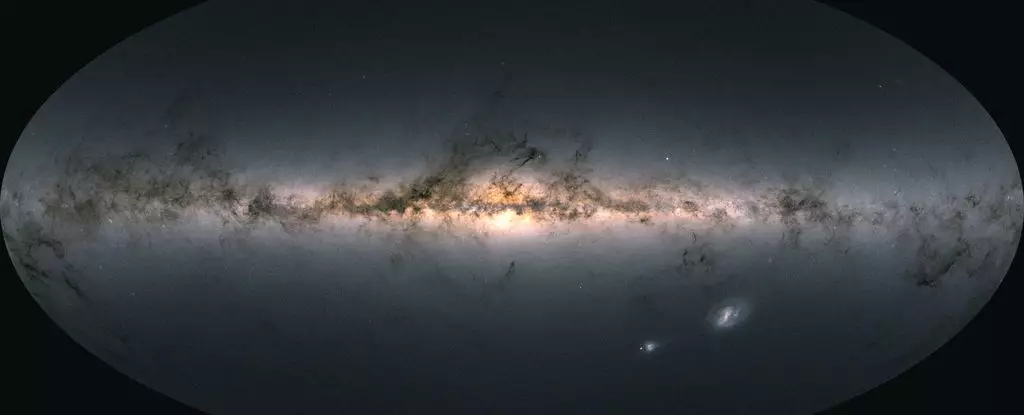Recent revelations have unveiled a tantalizing prospect in the realm of astrophysics: the possibility of a supermassive black hole lurking in the nearby Large Magellanic Cloud (LMC). Nestled within this dwarf galaxy, which orbits the Milky Way, researchers have detected signs of a colossal object weighing approximately 600,000 times that of our Sun. This discovery not only brings the black hole closer to our galaxy but also raises profound questions about its role in the grand tapestry of cosmic evolution.
The Large Magellanic Cloud is not just an ordinary galaxy; it’s on an inevitable collision course with the Milky Way. As the two galaxies spiral towards each other, the black hole concealed within the LMC is likely to follow suit. This revelation opens the door to significant insights into the nature of black holes, especially those that inhabit a mass range rarely documented in cosmic literature — specifically, masses under one million solar masses. The verification of this black hole’s existence could reshape our understanding of the pathways through which these mysterious entities grow from star-sized origins into massive behemoths, often weighing billions of solar masses.
Black holes remain among the most enigmatic subjects in astrophysics. Their elusive nature means that they do not emit detectable radiation unless they actively interact with surrounding matter. When a black hole accretes material, friction and gravitational forces generate immense heat, resulting in brilliant emissions that allow astronomers to infer their presence. However, in the absence of such interactions, black holes stay hidden, veiled in obscurity.
The quest to find these elusive giants often requires indirect methods. One particularly fruitful approach has involved observing the motion of stars within their gravitational influence. A notable success in this area was the identification of Sagittarius A*, the supermassive black hole at the heart of the Milky Way, achieved through the analysis of unusual star orbits. In contrast, the recent findings from Jiwon Jesse Han and collaborators pivoted to an alternative tracking method, focusing on hypervelocity stars.
Hypervelocity Stars: Clues to Hidden Worlds
Hypervelocity stars represent an extraordinary class of celestial objects that zip through the galaxy at speeds significantly exceeding the norm. They have become essential players in the search for hidden black holes. The discovery of such stars has been attributed to the Hills mechanism, a three-body interaction wherein a black hole interacts gravitationally with two stars. This interaction can result in one of the stars being ejected at hypervelocity, effectively serving as a cosmic signal pointing back to the presence of a lurking black hole.
Utilizing data from the Gaia space telescope, which meticulously mapped the Milky Way’s stars in three-dimensional space, Han’s team conducted a thorough analysis of 21 hypervelocity stars inhabiting the galaxy’s outskirts. Their study was meticulous, as they traced the stars’ journeys back to their origins, discarding unrelated acceleration theories. This groundbreaking effort yielded revealing results: 16 of the stars could be traced, with seven originating from the center of the Milky Way, but crucially, nine were linked to the Large Magellanic Cloud. Collectively, these findings suggested that these stars had been expelled due to the influence of a black hole that likely resides within the LMC.
Galactic Encounters on the Horizon
What does this mean for the future of our galactic neighborhood? Currently positioned around 160,000 light-years away, the Large Magellanic Cloud is set to engage with the Milky Way in approximately 2 billion years. This forthcoming collision and subsequent merger present an extraordinary opportunity for astronomers to witness the growth of black holes. If the potential hidden black hole in the LMC indeed exists, it may eventually journey towards the Milky Way’s center and merge with Sagittarius A*, resulting in an even more massive black hole.
The prospect of observing black holes merging and evolving through cosmic time underscores a broader understanding of galactic dynamics. It illustrates the intricate and often chaotic processes through which black holes can grow in mass and influence their surrounding environments.
The work of Han and his colleagues opens a new avenue for exploration in the field of astrophysics. As they continue to analyze the properties and characteristics of this potential black hole, the implications of their findings could lead to the confirmation of new models of cosmic evolution. With modern advancements in observational technology, the study of hypervelocity stars and black holes will remain a fertile ground for future research, offering windows into the enigmatic mechanisms that govern our universe.
In sum, the discoveries surrounding the Large Magellanic Cloud and its potential hidden black hole not only enrich our understanding of cosmic structures but also invite us to ponder the wonders of the universe in which we reside. As we marvel at the mysteries of black holes and their celestial dance, we find ourselves on the cusp of new revelations about the nature of existence itself.


Leave a Reply